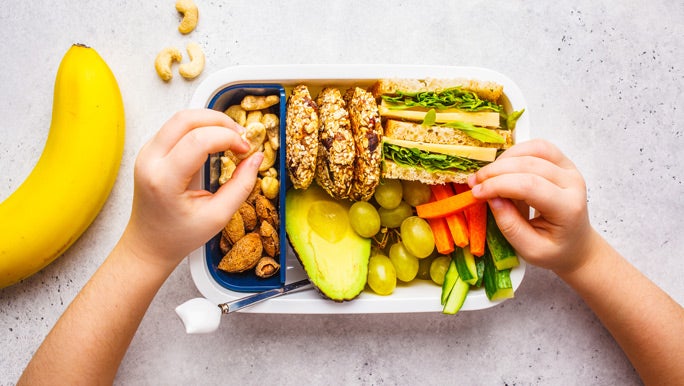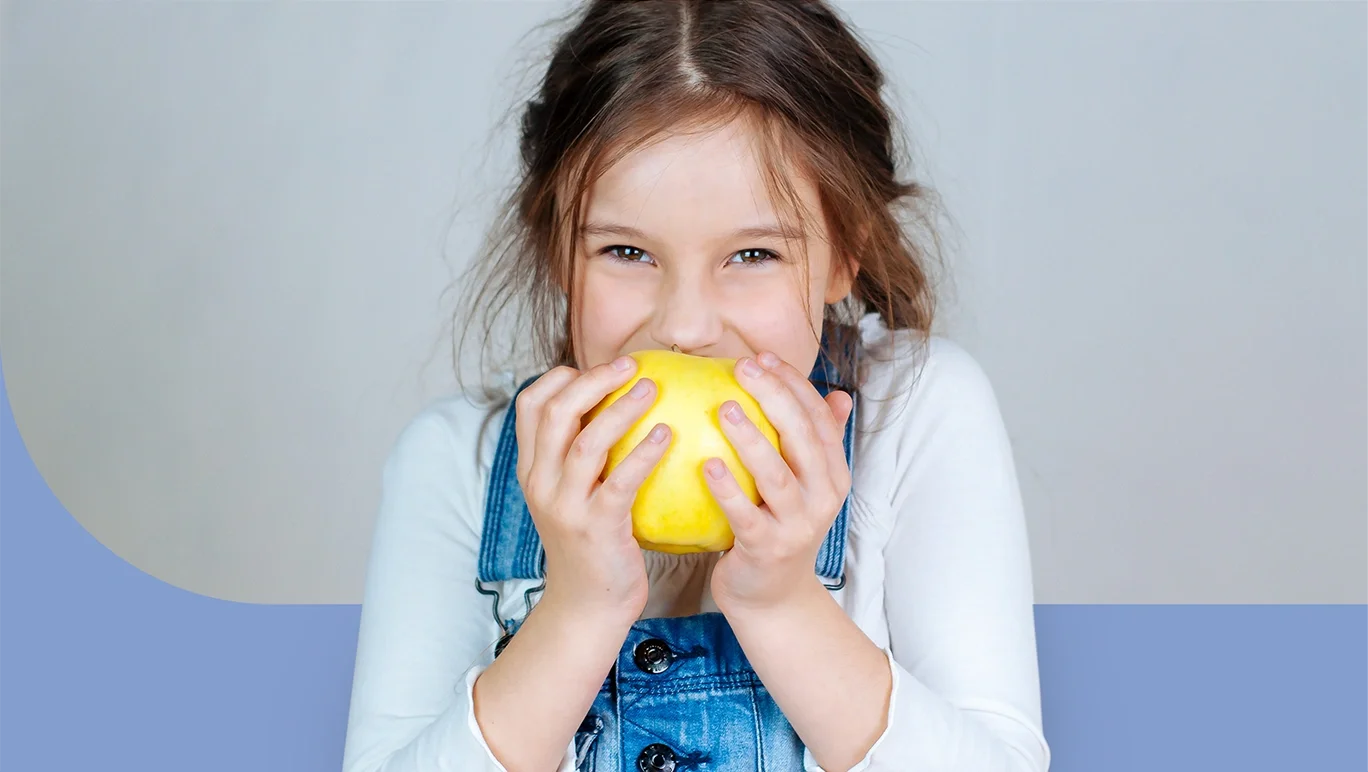If you would rather tear out your hair than prepare another meal or healthy snack for your kids, you’re not alone. Whether you’re struggling with food for fussy toddlers or healthy eating for teenagers, it can feel like an uphill battle.
What your kids should eat and actually convincing them to eat it can be two very different things.
Dietitian Shivaun Conn, wants you to know that she gets it. Feeding kids is a constant juggle that can be ridden with guilt. She also wants you to know that it doesn’t have to be that way. With some practical information and a few tips, you can overhaul your family mealtimes.
The importance of nutrition for kids
The reality is when we are talking about the best healthy food for kids, we are focused on nutrition. What we feed our kids isn’t a competition for who can have the cleanest plate. Instead, it’s about nourishing our kids with the food they need to focus, play and grow.
More than that, establishing good habits now will serve your child well into the future. If you’ve struggled with how to stop eating junk food and shifting your relationship with healthy food, you’ll know just how powerful this is.
Nutrition is important for all of us. We should all be eating food that is nutritious and gives us the energy, vitamins and minerals we need to go about our day. It’s no different for children.
The difference with nutrition for kids is that the food they eat plays a crucial role in their growth and development. They need particular nutrients for healthy bone, muscle and brain development. Not to mention the impact of food on focus. Without that focus, they can’t learn what they need during long days at school.
What should kids actually be eating?
Shivaun advocates for avoiding the word ‘best’ and maintaining neutrality around food.
“It’s not about eating what’s best… It’s about eating nourishing foods that will power your kids through the day. It’s frustrating when you cook a nutritious meal for your kids and they don’t eat it. But when you become emotional and tell them they have to eat it, they can start to develop negative food associations,” she says.
Neutrality means acceptance. Accept that your child didn’t eat a particular food rather than worry about it. The most important thing is to persevere and present them with food in different ways.
So, what is it that kids should actually be eating? That all depends on their age and gender. According to the Australian Dietary Guidelines, every day kids should eat:
- 2-5 ½ serves of vegetables
- ½-2 serves of fruit
- 4-7 serves of grain foods (ideally wholegrain) such as cereal, bread, brown rice or wholegrain pasta
- 1-2 ½ serves of lean meat and poultry, fish, eggs, nuts and seeds, and legumes/beans
- 1-3 ½ serves of milk, yoghurt, cheese and/or alternatives (mostly reduced fat)
- 0-5 serves of discretionary choices and spreads/oils, or additional serves of foods from the five groups
You will need to check the guidelines against the age and gender of your child to see where they fall within those ranges.
If you’re wondering how to introduce new foods to your picky eaters, Shivaun has this advice for you.
“Get your kids involved with food. Even if it’s as simple as helping you pack the groceries away. You can create opportunities to introduce your kids to new foods and talk about them as you go. Then when you serve that food up for dinner or a snack, it’s not completely foreign to them,” she says.
Shivaun also advises that you shouldn’t become disheartened if your kids don’t like a food the first time you serve it. Try it again, but perhaps present it differently. You may be surprised that they eventually try it and can’t get enough of it.

Healthy snacks for kids should be nutrient-dense to help meet their nutritional requirements.
A note on protein
Have you heard of amino acids? Our bodies produce 11 of the 20 essential amino acids. We source the other nine from food, namely protein.
Protein is an important macronutrient for kids. It’s the building block for growing strong bones and muscles as well as the hormones and enzymes the body needs. Protein plays an important role in muscle growth and repair.
If a child doesn’t get adequate protein when they’re growing, it can impact their development. It can also make them lethargic, limit their ability to focus and even reduce their immune system response. Remember to see an Accredited Practicing Dietitian for specific dietary advice for your children though.
You probably know that meat is a good source of protein. But it’s not exactly the most exciting food for kids to eat. If you have a carnivore on your hands, that’s great. If not, Shivaun says there are many good protein foods for kids. You can (and should) eat a variety of them, including:
- lean meat and poultry
- fish and seafood
- eggs
- milk, cheese, yoghurt and other dairy products
- nuts, seeds, legumes and beans
If your kids love pasta with red sauce, try cooking a bolognese with lean beef mince and kidney beans to go with it. Sprinkle crushed nuts on their vegetables, or make a smoothie with milk and Greek yoghurt.
If you’re following the Australian Dietary Guidelines for the number of serves of the five food groups, then you should be hitting the protein target.
Snacks are opportunities
Shivaun wants you to consider snacks as opportunities. Healthy snacks for kids should be nutrient-dense to help meet their nutritional requirements. Rather than trying to squeeze those recommended servings into your main meals, use snacks as a boost.
However, as a word of caution, don’t turn to fruit as your go-to snack. According to the Australian Dietary Guidelines, toddlers only need ½ serve of fruit a day. For 2-3 year olds it’s 1 serve of fruit, and 1 ½ serves for 4-8 year olds. It’s only when kids are 9 years old that they should eat 2 servings of fruit a day.
Also, avoid giving kids too much fruit during the day or they may struggle to meet their other nutritional needs. Forget about the old Australian food pyramid and instead focus on servings.
So, what are easy and healthy snacks for kids that they will love to eat? Here’s some of Shivaun’s approved ideas:
- Vegetable sticks such as carrot, cucumber, baby corn, green beans and celery or other crunchy vegetables such as capsicum and snow peas. Serve them with hummus or a nut butter for an extra protein hit.
- For a protein snack, try a boiled egg or a handful of nuts. A small bowl of unflavoured Greek yoghurt topped with berries, or drizzled with a little honey (for kids older than 1) will also help to reach the dairy servings and protein requirements.
- Serve whole grain crackers with sliced cheese, cottage cheese or even a nut butter or healthy dip.
- If you want to make some fun healthy snacks to keep on hand for the kids, bliss balls are a great idea. A healthy bliss ball recipe will usually include ingredients like oats, chia seeds and nuts (or nut butters), so they are packed with goodness.

If your kids enjoy popcorn, try air popping your own at home and flavouring it with a sprinkle of parmesan cheese.
Unhealthy treats aren’t the enemy
You’ve now got a few ideas for healthy snacks for your kids to help meet their daily nutrition targets. But, that doesn’t mean that you can’t feed your kids unhealthy treats! Far from it. In fact, nobody should be completely deprived of unhealthy treats every now and then.
Unhealthy treats become a problem when they are replacing other nutritious wholefood options in a child’s daily diet. Shivaun is also a big advocate for giving unhealthy treats and meals a makeover to make them more nutritious, while still retaining the flavour.
If your kids enjoy popcorn, try air popping your own at home and flavouring it with a sprinkle of parmesan cheese. Or make ‘nice-cream’ by blending frozen fruit with milk or greek yoghurt to create a healthy ice-cream. They’ll still think they’re getting a treat, but they’re actually eating a healthy snack.
Rome wasn’t built in a day
Good things take time. You might look at what your kids are eating and realise that you have a long way to go to meet the recommended guidelines. If so, make any changes slowly to ensure they stick.
If you suddenly remove everything familiar and delicious from your kids, it will make the whole process much harder.
Remember, you’re doing a great job. Don’t put too much pressure on yourself – just revamp your food choices one healthy snack at a time.
Related:
• How can I help my kids to be more resilient?
• What is a dietitian and why use one?
• Is sugar really as bad as it’s made out to be?
Shivaun Conn is an Accredited Practising Dietitian, Accredited Nutritionist and Certified Health Coach with particular interests in nutrition, lifestyle, executive health and health behaviour change.
Reviewed by the healthylife Advisory Board June 2012


